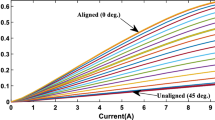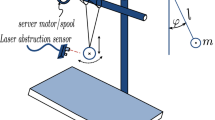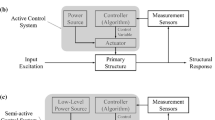Abstract
Acceleration and deceleration of a mover excite unwanted vibration to the system base, causing a significant reduction of life and productivity to manufacturing equipment. The system base vibration of a linear motor motion stage can be reduced with a passive reaction force compensation (RFC) mechanism. However, the passive RFC mechanism cannot provide the capability to adjust its stiffness and damping coefficient in real-time. Therefore, resonance may occur if the frequency of the passive RFC mechanism accidentally matches with the frequency components of applied motion profile. This paper presents a semi-active RFC method for a linear motor motion stage using an additional fixed coil. The semi-active RFC mechanism can adjust damping coefficient by changing the resistor load or switching the period of the additional fixed coil. The semi-active RFC mechanism also does not require an additional amplifier or control axis. Mathematical analysis of the semi-active RFC is presented to demonstrate the adjustable damping capability by changing the load resistor. Finally, the effectiveness of the proposed semi-active RFC mechanism is verified via simulations and experiments.
Similar content being viewed by others
Abbreviations
- a-b-c :
-
a-b-c three phase coordinate
- a M :
-
acceleration of the mover
- c coil :
-
damping coefficient of fixed coil
- c MT :
-
damping of magnet track
- F coil :
-
Lorentz force of the fixed coil
- F t :
-
thrust force of the mover
- F tran :
-
transmitted force via fixed coil
- I a,b,c :
-
three phase currents in a-b-c frame of fixed coil
- I ab,bc,ca :
-
currents in resistor loads
- I d,q :
-
currents in d-q frame
- I q peak :
-
peak current of fixed coil in q axis
- K emf :
-
electromotive force gain
- K f :
-
force constant of fixed coil
- k MT :
-
stiffness of magnet track
- L coil :
-
inductance of fixed coil
- L d,q :
-
inductance of fixed coil in d-q frame
- L q load :
-
inductance of fixed coil in q axis
- m MT :
-
mass of the magnet track
- m M :
-
mass of the mover
- p :
-
number of pole pairs
- R load :
-
load resistance
- R q load :
-
resistor of load in q axis
- R coil :
-
resistance of fixed coil
- R q coil :
-
resistor of coil in q axis
- V a emf :
-
electromotive force of fixed coil in q-axis
- x M :
-
position of mover
- \({\dot x_M}\) :
-
velocity of mover
- x MT :
-
position of magnet track
- \({\dot x_{MT}}\) :
-
velocity of magnet track
- τ :
-
magnet track pole pitch
- ψ :
-
flux linkage of magnet track
References
ASML, “TWINSCAN NXT: 1960Bi,” http://www.asml.com/asml/show.do?lang=EN&ctx=46772&dfp_product_id=7414 (Accessed 19 APR 2016)
Tseng, Y.-T. and Liu, J.-H., “High-Speed and Precise Positioning an X-Y Table,” Control Engineering Practice, Vol. 11, No. 4, pp. 357–365, 2003.
Cho, K.-J., Choi, D.-S., and Ahn, H.-J., “Mechanism and Control of Reaction Force Compensation of XY Linear Motion Stage System,” Transactions of the Korean Society of Mechanical Engineers A, Vol. 35, No. 6, pp. 599–607, 2011.
You, Y.-h. and Ahn, H.-J., “A Passive Reaction Force Compensation (RFC) Mechanism for a Linear Motor Motion Stage,” Int. J. Precis. Eng. Manuf., Vol. 15, No. 5, pp. 797–801, 2014.
Nguyen, D. C. and Ahn, H.-J., “Dynamic Analysis and Iterative Design of a Passive Reaction Force Compensation Device for a Linear Motor Motion Stage,” Int. J. Precis. Eng. Manuf., Vol. 15, No. 11, pp. 2367–2373, 2014.
Ahn, H.-J., “Eddy Current Damper Type Reaction Force Compensation Mechanism for Linear Motor Motion Stage,” Int. J. Precis. Eng. Manuf.-Green Tech., Vol. 3, No. 1, pp. 67–74, 2016.
Nguyen, D. C. and Ahn, H.-J., “A Fuzzy-P Controller of an Active Reaction Force Compensation (RFC) Mechanism for a Linear Motor Motion Stage,” Int. J. Precis. Eng. Manuf., Vol. 16, No. 6, pp. 1067–1074, 2015.
Karnopp, D., “Permanent Magnet Linear Motors Used as Variable Mechanical Dampers for Vehicle Suspensions,” Vehicle System Dynamics, Vol. 18, No. 4, pp. 187–200, 1989.
Cassidy, I. L., Scruggs, J. T., Behrens, S., and Gavin, H. P., “Design and Experimental Characterization of an Electromagnetic Transducer for Large-Scale Vibratory Energy Harvesting Applications,” Journal of Intelligent Material Systems and Structures, Vol. 22, No. 17, pp. 2009–2024, 2011.
Ponomarev, P., “Control of Permanent Magnet Linear Synchronous Motor in Motion Control Applications.” M.Sc. Thesis, Faculty of Technology, Lappeenranta University of Technology, 2009.
Delta Tau, “Power PMAC User’s Manual,” 050-PRPMAC-0U0, 2014. ftp://87.245.120.68/support/Hardware/PowerPmac/Users%20Manual/Power%20PMAC%20Users%20Manual.pdf (Accessed 19 APR 2016)
Ahn, H. J. and Kim, K. R., “2D Hall Sensor Array for Measuring the Position of a Magnet Matrix,” Int. J. Precis. Eng. Manuf.-Green Tech., Vol. 1, No. 2, pp. 125–129, 2014.
Pham, M. N. and Ahn, H.-J., “Horizontal Active Vibration Isolator (HAVI) Using Electromagnetic Planar Actuator (EPA),” Int. J. Precis. Eng. Manuf.-Green Tech., Vol. 2, No. 3, pp. 269–274, 2015.
Author information
Authors and Affiliations
Corresponding author
Rights and permissions
About this article
Cite this article
Nguyen, D.C., Ahn, HJ. Semi-active reaction force compensation for a linear motor motion stage. Int. J. Precis. Eng. Manuf. 17, 857–862 (2016). https://doi.org/10.1007/s12541-016-0104-y
Received:
Revised:
Accepted:
Published:
Issue Date:
DOI: https://doi.org/10.1007/s12541-016-0104-y




